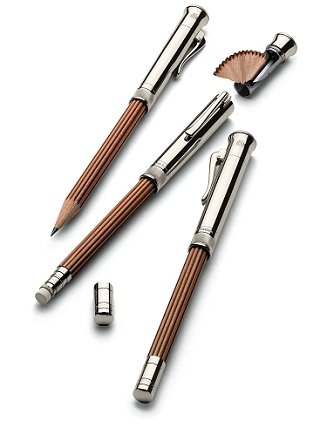
How to See Around the Corner: Positioning Your Company for Market Shifts
From the economy to customer behavior, many variables could impact your business’ viability in the future. Learn how to look around the corner to what’s ahead.
As an artist, I appreciate a good pencil. In fact, I'm in the market for the PERFECT pencil. This isn't just any pencil - it's a $40 work of art that has a built-in sharpener and a clip allowing you to take it to meetings, brainstorm sessions, and any other place where pens are the norm. Here's a photo from the manufacturer's website:

In deciding where to buy this pencil, I was faced with a few options - several online stores and -possibly- a local retailer. But before I share with you my final buying decision, I'd like to tell a story about good design and how it can directly relate to increased sales.
Last week I met with a new client who was interested in revising their brand and website. The business recycles, manufactures, and reconditions pallets. Though it may not sound sexy, it's a very successful business and seemingly immune to the current economic downturn.
One of the questions that came up during our meeting was how to calculate return on investment (ROI). In other words, if they worked with Kinesis, what would be the "payback" period on a new brand, website, and other sales materials?
What a great question! After all, this is the fundamental question all business owners ask when considering a new piece of equipment, additional employees, or other capital expenditures.
Finding the answer to this question with a high degree of accuracy would require an investment in and of itself. You'd need focus groups, multiple design options, and various messaging. While Fortune 500 companies can - and do - engage in these kinds of studies, it's not practical for the rest of us.
Fortunately, there's an easier solution that any business owner can use: calculating the Lifetime Customer Value (LCV).
In simple terms, LCV is the total amount of revenue from a single new customer. In other words, if a new customer spends $1,000 a year and they keep spending this amount for 5 years, then the LCV is $5,000. If your costs of acquiring and maintaining that customer are less than $5,000, then the customer can be viewed as profitable (this is a rather simplistic model, as you'd want to take into account other factors like client retention costs, referral benefits, etc). Nevertheless, LCV is a great starting point.
So, once you've figured out the LCV, it's time to assess whether or not your potential customers are using the web to inform their buying decisions. If you're selling widgets, for example, and these widgets are exactly the same as your competitor's widgets, how can you entice customers to buy from you? If you're selling a professional service (or a service/product hybrid like the pallet company), is your website, brand, and sales collateral making it easier to close deal? Do you go to sales meetings feeling like your materials don't stand up to the competition?
This is where many businesses fail to see the big picture: That while they may not be selling online, your customers are using the web to decide if they want to buy from you. In fact, most of the time, you won't even know that a new customer is considering your services.
So let's get back to my $30 pencil. After a rather lengthy search, I found three websites that appeared to sell the same product. Here's a screen shot of each site, along with the price for the product (minus shipping):
Looking at these websites, it's clear that there's a wide range of design sophistication. Pen City, for instance, features blurry, camera-phone quality photographs, a bizarre navigation system, and a decidedly 1995 aesthetic (in computer years, it would be too old even for the AARP).
Pen Gallery features (ironically) two guys seated on a couch using computers, a rather generic "out of the box" layout, and an oh-so-informative date/time tracker in the upper right corner. The photo of the product is actually more infromative, but the business location (Malaysia) is a deal breaker for most.
Last, but not least, is Akar. While it's not entirely clear if they are an online store, an architecture firm, or both, their site design inspires confidence. They look like a REAL business who has their act together. Even though they are more expensive than Pen City, I instinctively TRUST that they will deliver on their promise to provide what I'm looking for. It also doesn't hurt that they have a real, physical address.
In truth, none of these options are perfect, but I'll probably end up going with Akar because their design, messaging, and professionalism come through in their website. It's not the cheapest product, but I'm willing to spend more (nearly 20%) for the sense of security that comes with buying from someone who has their act together.
So how do pens relate to pallets? Simply put, as with pen-shoppers, people in need of pallets will invariably use the web to find a vendor they can work with. Or, if they are thinking about using my client for these services, they will review my client's website as part of their buying process.
The question my client needs to answer is 1) How do they compare to the competition and 2) how much will it cost them if we lose business due to a weak brand and website? Once they know the Lifetime Customer Value, it's an easy exercise to determine the payback time on their design investment. I'm betting the payback period will be a lot shorter than they expect!
Get insights like this straight to your inbox.